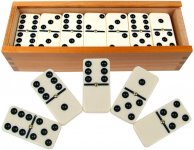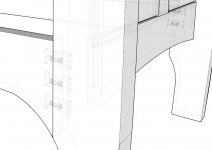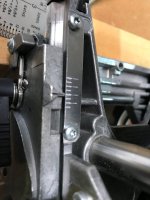You don't need a fancy mortise and tenon jig or a Domino to get good M&T joints. The old square mortising drill/chisels and mortising machines were very crude when compared to making mortises with a router. Making "floating tenons" that fit perfectly is quite easy with a table saw and a planer. You quite likely already have both of these.
You can go with "floating tenon" joints quite easily. You can make a jig so the mortises can be easily cut with a router, a guide bushing, and an up spiral bit. Plunge the bit straight in many times, moving over about 3/4 of the bit diameter each time to clear out the bulk, then slide the plunged router bit end to end in the mortise, and then once all the way around tightly against the jig guide to assure that all sides have been completely cleaned. Your mortise is now complete. Repeat this on your mating work piece. Use the same edge of your jig lined up with the face side of your work piece when routing both mating work pieces, if you want the face sides of both to line up when the joint goes together.
Make your floating tenon stock using your table saw for the tenon long, but the width and rough thickness needed, and then use a thickness planer to get the thickness exactly the width of your previously cut mortises. Then cut them to length with the chop saw as you need them, with the length determined by 2X the depth of your mortise, minus 1/8" (You don't want the tenon to bottom out and prevent the joint from going fully together). Don't worry about rounding the tenon ends to fit the rounded ends of the mortise. Just make them fit the flat sides of the mortise and leave the 1/2 round ends of the mortise for the excess glue to squeeze into. The strength of the joint is in how well the flat side surfaces of the mortise and tenon fit together. Dry, they should slide together with very light pressure and no rattle, but not require a mallet to push them together either. You want a few thousandths space for the glue.
About 18 years ago I took on a job that had over 1,600 M&T joints, and searched long and hard to find a good way to make them quickly, easily, and with the precision needed to be able to avoid the the hand fitting that was required for the old square drill/chisel mortise and table saw tenon cuts, followed my rabbet planning of the tenons to fit those poorly cut mortises. I tried many jigs that were on the market, and none could make both the mortise and the tenon well enough so they didn't need trimming and fitting until I bought a Leigh FMT now called FMT Pro jig. With the same setup I can cut both the mortise and matching tenon, and there is an adjustment on the jig that lets you tune the joint tightness. Once set, you can make hundreds of mortises and tenons of the same size and all will be a perfect fit to each other with no fine tuning. Any tenon will fit any mortise. This FMT jig paid for itself easily twice over on that one job.
I have since tried this "Floating Tenons" method mentioned above, and would likely have done that job with floating tenons and not bought the FMT jig if I had known how it easy it was. With matching mortises in both work pieces, floating tenons can be very easy to do and are almost as accurate as using the FMT jig, when made the way that I described above. There once was a jig on the market called a "Mortise Pal" that eliminated the need to make the jig for routing the mortises for floating tenons, but the manufacturer is out of business. I have a friend who has one and I now wish that I had bought one when they were available, but sadly I didn't. Either do some research on the "Mortise Pal" jig and copy it's design, or come up with a version of a router bushing guided jig for mortising from YouTube videos and then make one. Most can be made quite easily. The jig doesn't need to be perfect as long as you can make all of the mortises the same with it. You then just need to make the tenon stock to fit them, what ever the mortise width ends up being. The planer lets you get the tenons to be a perfect fit very easily no matter what the final width of the mortise is. Keep your jig and left over tenon stock for the next time that you need them.
Charley






 I just keep thinking back to how long (years) I labored over the decision to buy my track saw. That was over $600 and it hurt... a lot. However, it is turning out to be one of the best investments I've ever made in the shop as it has saved me dozens of hours in the year or so I've had it and I'm sure it will continue to do so as I find new ways to incorporate it into my builds.
I just keep thinking back to how long (years) I labored over the decision to buy my track saw. That was over $600 and it hurt... a lot. However, it is turning out to be one of the best investments I've ever made in the shop as it has saved me dozens of hours in the year or so I've had it and I'm sure it will continue to do so as I find new ways to incorporate it into my builds.